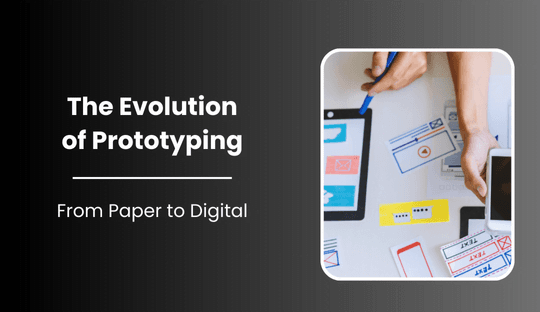
The Evolution of Prototyping: From Paper to Digital
Prototyping is a fundamental aspect of the design and development process, allowing designers to visualize and test their concepts before committing to full-scale production. At Flykez CO, a leading creative brand company in Liechtenstein, we excel in website design & development, search engine optimization, brand design & brand identity, digital marketing, and UI & UX design. This blog post explores the evolution of prototyping from traditional paper methods to advanced digital techniques, highlighting the impact of this evolution on design efficiency and innovation.
The Early Days: Paper Prototypes
In the early stages of design, paper prototyping was the go-to method for visualizing ideas. This technique involved sketching layouts and interfaces on paper, providing a tangible way to communicate design concepts.
Advantages of Paper Prototypes:
- Simplicity: Paper prototypes are easy to create and modify, making them ideal for brainstorming sessions and initial design explorations.
- Cost-Effective: With minimal resources required, paper prototyping is a cost-effective way to experiment with different design ideas.
- User Testing: Paper prototypes facilitate quick user testing, allowing designers to gather feedback and iterate on their designs early in the process.
Transition to Low-Fidelity Digital Prototypes
As technology advanced, designers began transitioning from paper to low-fidelity digital prototypes. These prototypes, often created using wireframing tools, provided a more structured and detailed representation of the design.
Benefits of Low-Fidelity Digital Prototypes:
- Enhanced Detail: Digital wireframes offer more precision and detail compared to paper sketches, helping designers visualize the layout and structure more accurately.
- Easy Modifications: Digital tools allow for quick and easy modifications, enabling iterative design processes without the need to start from scratch.
- Collaboration: Digital prototypes can be easily shared with team members and stakeholders, facilitating better collaboration and feedback.
Tools Used:
- Balsamiq: Known for its simplicity, Balsamiq is a popular tool for creating low-fidelity wireframes quickly.
- Sketch: A versatile design tool that supports wireframing and more detailed design work.
The Rise of High-Fidelity Prototypes
With the advent of more powerful design tools, high-fidelity prototypes became the standard. These prototypes include detailed design elements such as typography, color schemes, and interactive components, closely resembling the final product. Also read About How to Turn Your Ideas into Prototypes Quickly
Advantages of High-Fidelity Prototypes:
- Realistic Representation: High-fidelity prototypes provide a realistic representation of the final product, making it easier to identify and address potential issues.
- Interactive Elements: These prototypes can include interactive elements, allowing for more comprehensive user testing and feedback.
- Stakeholder Buy-In: The detailed and polished nature of high-fidelity prototypes helps secure buy-in from stakeholders and clients.
Tools Used:
- Adobe XD: A powerful tool for creating high-fidelity prototypes with interactive elements.
- Figma: A cloud-based design tool that supports real-time collaboration and high-fidelity prototyping.
The Impact of 3D Prototypes
The latest advancement in prototyping involves the use of 3D elements. 3D prototypes bring designs to life by adding depth and interactivity, enhancing the overall user experience.
Benefits of 3D Prototypes:
- Enhanced Visualization: 3D prototypes provide a more immersive and realistic visualization of the design, helping stakeholders understand the spatial relationships and interactions.
- Improved User Experience: By simulating real-world interactions, 3D prototypes allow designers to create more engaging and intuitive user experiences.
- Innovative Designs: The use of 3D elements encourages innovative design solutions that go beyond traditional 2D interfaces.
Tools Used:
- Blender: A versatile tool for creating 3D models and prototypes.
- Unity: A powerful platform for creating interactive 3D experiences.
The Future of Prototyping: Rapid Prototyping and Beyond
As technology continues to evolve, rapid prototyping has emerged as a key trend. This approach involves quickly creating and testing prototypes to accelerate the design and development process.
Advantages of Rapid Prototyping:
- Speed: Rapid prototyping allows for quick iteration and testing, shortening the design cycle and speeding up time-to-market.
- Flexibility: The ability to quickly create and modify prototypes provides greater flexibility in exploring different design solutions.
- Early Validation: By testing prototypes early and often, designers can validate ideas and make data-driven decisions throughout the development process
Conclusion
The evolution of prototyping from paper to digital has revolutionized the design process, making it more efficient and effective. At Flykez CO, we leverage the latest prototyping techniques to deliver innovative and user-centric designs. Whether you’re a startup looking to validate your ideas or an established company aiming to improve your digital presence, our expertise in prototyping can help you achieve your goals.
For more information about our services and how we can assist you in your design journey, visit our website at www.flykez.com. Let Flykez CO be your partner in creating exceptional digital experiences.
